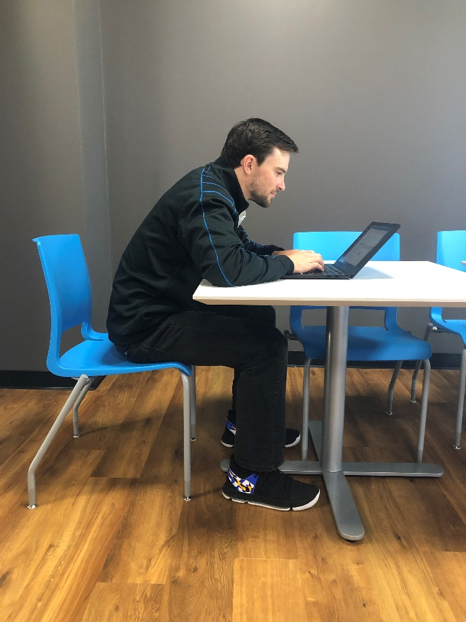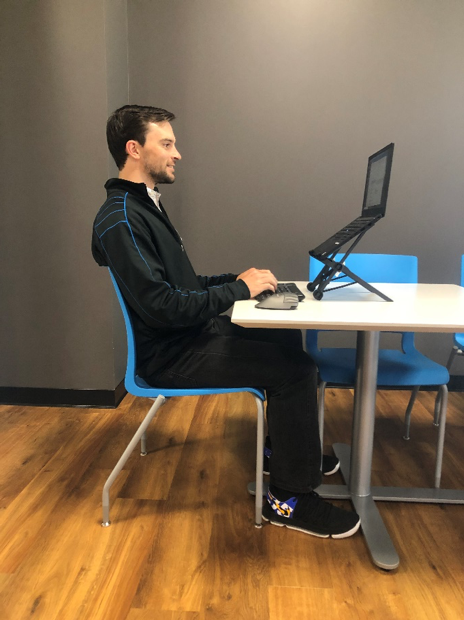Whether working at home, the local coffee shop or at another office on campus, it is imperative to set-up your workstation to allow for neutral postures. The cumulative effect of working on laptops, cell phones, and tablets may increase the risk of chronic neck/shoulder injuries and repetitive stress injuries of the hands and wrists.
Stanford EH&S Mobile Ergonomics Webinar from Stanford University EH&S on Vimeo.

Setting up your Workstation at Home:
Ergonomics Training -> EHS-3400 – Telecommuters are encouraged to take this online training in STARS at their home workstation to help ensure proper setup. An alternative is completing the online self-assessment form.
When telecommuting, EH&S Ergonomics recommends the use of an:
- External keyboard
- External mouse
- External monitor or laptop riser to maintain neutral, upright postures
Chair:
- Use a chair that allows your seated elbow height to match the worksurface height.
- Feet should be fully supported, either on the ground or footrest.
- Avoid sitting on the edge of your seat, hips should be back with your spine fully supported by the chair.
-
- DIY Hacks:
- Try using a small box or crate for a footrest.
- Explore the use of cushions and pillows to provide support when necessary.
- If needed, use a rolled-up towel for added spine support. The towel should run the length of the spine. Place it between the shoulder blades to encourage a more upright posture when seated.
- Consider using the BackBone Cushion.
- DIY Hacks:
Work Surface:
- The keyboard and mouse should be positioned at seated elbow height.
- Avoid overreaching; the elbows should hang naturally by your side and keep the mouse directly next to the keyboard.
-
- DIY Hacks:
- Switch it up – Consider short term standing at a taller counter or using an ironing board, but do so strategically. Note, the neck posture will likely be compromised so keep it to short durations (less than 20 minutes). It is best to perform your work tasks in a variety of ways (i.e. sit, stand, etc.), instead of the same repetitive movements.
Monitor:
- Adjust the monitor height so the top 1/3 of the monitor is eye-level.
- Ideally, your laptop is docked into an external monitor.
- If you do not have an external monitor, raise your laptop to eye level with a riser or books.
| Before | After |
 |
 |
- For specific equipment recommendations, refer to the EH&S Pre-Approved Computer Ergonomics Product List
- The Stanford Surplus Storeoffers discounted furniture, free external monitors (for Stanford work) and additional equipment that can help reduce personal cost of providing an ergonomic workstation in your home office. EH&S also recommends consulting with your Local IT for potentially spare keyboards/mice that can be used when working from home.
- University IT also has standard equipment recommendations (for both Mac and PC) in their Technology Toolkit for Telecommuting and Remote Work website.
Things to Consider when Working from Home:
- Consider the working environment – Have a designated working area. Move the items that are frequently used close to the body to reduce overreaching. Set up your desk properly with everything you need.
- Work smarter – From video calls to instant messaging apps, there are many ways to keep in touch and boost productivity, as well as feelings of camaraderie, rather than isolation.
- Even though you are at home, try hard to treat work like work. Keep a reasonable routine and set clear and defined boundaries between work and personal life. Start each day by getting dressed, reviewing your schedule, making a to-do list, thus getting into an “I’m at work” mind-set.
- Regular meetings and communication are essential – the only difference is that people might be in different locations.
- Take breaks away from your desk too – go to the gym or walk the dog, especially if you tend to have a working lunch.
- Keep yourself fueled. Drink plenty of water and eat regular, nutritious meals and snacks to help remain focused.
Breaks:
- Take a one to two-minute microbreak every 20 to 30 minutes to reduce sustained awkward postures and repetitive motions.
- Breaks are emphasized when using a laptop or other ergonomically-compromised work stations.
- Refer to the Stretching & Microbreaks pages for more information.
- Consider downloading StandUp!; a free break reminder app.
Ergonomic Evaluations: Working from Home
If you identify any red flags or need assistance with potential solutions, EH&S requests a series of 3 pictures to help determine what adjustments need to be made and/or what equipment may be beneficial. If necessary, please ask someone to take the following pictures of you while you are seated from 3 angles:
- Profile (side)
- Top view
- From behind
Once you send the pictures, we can schedule a phone call to review your set-up, address your concerns, and determine next steps.
For additional support, please contact Stanford Ergonomics at ergonomics@lists.stanford.edu
Additional Resources:
- Work at Home Office Safety Checklist
- Tablet/Smart Phone Best Practices
- Laptop Guidance
- Computer Workstation Ergonomics Evaluation Form
- Admin Guide on Telecommuting
